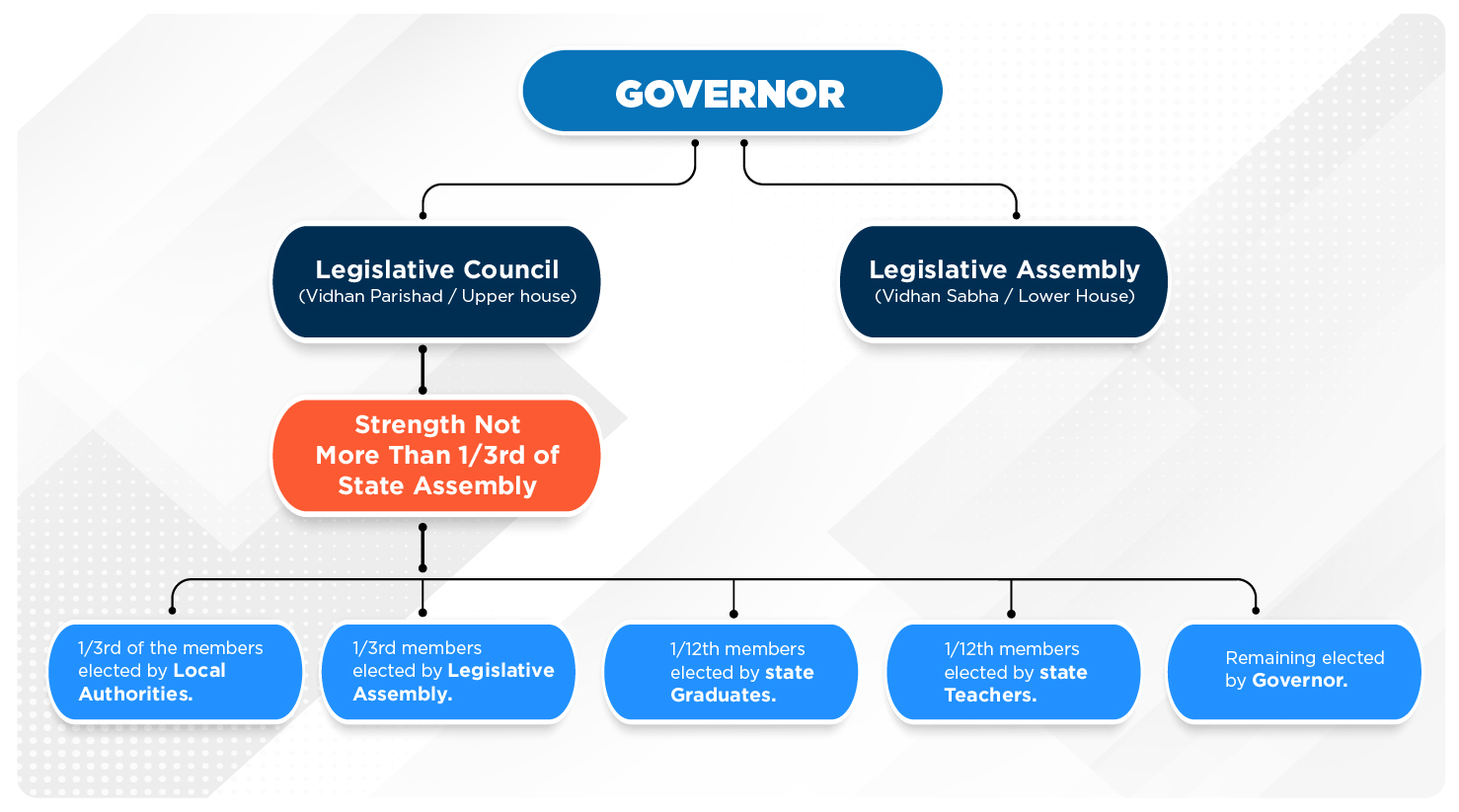For those who are unaware of the nitty gritties of the Indian democratic structure, a closer look into it will definitely pique curiosity as to why a few Indian states have two houses under state legislation and a few states do not. What is the genesis behind the State Legislative Council and what are the roles it entails? Let’s find out.
What is a Legislative Council?
India follows a bicameral system at both the centre and state level, under which some Indian states have two houses—the State Legislative Council and the State Legislative Assembly. In these cases, the Legislative Council is the upper House and the Legislative Assembly functions as the Lower House of the State Legislature of those states. A Bicameral legislature replicates the archetype followed in Indian Parliament where the lower house wields greater legislative power as compared to the upper house. The Constitution of India, allows provision of establishing bicameral legislatures in more populous states of the country. Initially states such as Tamil Nadu, West Bengal, Madhya Pradesh, Punjab, Assam etc. were slated to have two houses, however, some of the states felt that the Legislative Council would be an unnecessary supplement.
The State Legislative Council is also denoted with various names, such as Vidhan Parishad or Saasana Mandali, amongst others. The establishment is defined in Article 169 of the Indian Constitution, which states that the Constitution grants every state the right to create or abolish Legislative Council. The Parliament can then make it a law by passing it like any ordinary bill which doesn’t require any amendment to the Constitution. As of 2021, 6 out of 28 states have a State Legislative Council. These states are:
- Andhra Pradesh
- Karnataka
- Maharashtra
- Bihar
- Telangana
- Uttar Pradesh
State Legislative Council: The Structure

The significance of a bicameral legislature in India lies in the fact that the parliamentary system on national and state level has to deal with complex issues of administering, thus to adequately respond to the tremendous diverse Indian politics and to frame laws that justify and represent citizens from every strata of society, the concept of bicameral legislation was adopted.
Legislative Council is a permanent body whose members are chosen from members of local bodies such as corporations, municipalities, and district councils. The strength of any council shall not exceed 1/3rd of the strength of the state assembly. But for smaller states, the minimum strength of the council can be forty (40). The members of the Legislative Councils comprise of people elected through five different constituencies.
- One third (1/3rd) of the members are elected by representatives of the Local Authorities (like Municipalities, Zilla Parishads, Block Parishads etc)
- One third (1/3rd) of the members are elected by members of the Legislative Assembly (the same person can’t be a member of both the houses)
- One-twelfth (1/12th) of the members are elected by the Graduates in the state
- One-twelfth (1/12th) of the members are elected by the Teachers in the state
- The remaining members are nominated by the Governor. Those nominated by the Governor should have special knowledge or practical experience in Literature, science, art, co-operative movement and social service.
The tenure of an MLC is 6 years. The 1/3rd of the members who represent the State Legislative Council usually retires every two years. There are specific criteria for becoming an MLC. These include the following:
- Being a citizen of India;
- Having the age of at least 30 years;
- Mentally sound person;
- Not an insolvent individual;
- Enrolled in the voter’s list of the respective state of election;
- One cannot be an MP or MLA at the same time.
The Karnataka Legislative Council:

In the Kannada language, it is called the Karnataka Vidhana Parishad, and it is the Upper House of the bicameral Legislature of Karnataka. It entails a 6 renewable year tenure. The composition of the State Legislative Council must not be more than one-third of the membership of the State Legislative Assembly. However, at the same time, it cannot have less than 40 members. A permanent body, the Karnataka Legislative Council, comprises 75 members, with one-third of its members retiring every two years. Out of the 75 members of the Karnataka Legislative Council:
- The Karnataka Legislative Assembly elects 25 members;
- The local authorities select 25 members;
- The Graduates elect 7 members;
- The Teachers elect 7 members;
- The Governor of Karnataka nominates the remaining 11 members.
Creation and Abolition of State Legislative Councils:
As Article 169 of the Constitution of India describes, the Parliament of India has the power to create or abolish the State Legislative Council of a state-provided that the state’s legislature passes a resolution for that with a special majority. As far as the existence of a State Legislative Council goes, it has proven to be politically controversial. In terms of its position, the State Legislative Council is a weak chamber. It does not possess any absolute authority. That is why most states have opted not to have this House.
Quite a few states have even got their Legislative Council abolished, only to request for it to be re-established. On the other hand, proposals for the re-establishment of certain State Legislative Councils have been met with opposition. However, suggestions for abolition or re-establishment of a state’s Legislative Council can only be confirmed by the Parliament of India.
The Roles & Responsibilities Of The State Legislative Council:

As per the Indian Constitution, the Legislative Council has limited power, with following limitations:
- It cannot make or break a government.
- It cannot say ‘No’ to the Finance Bills.
However, the perks include the following:
- The Council’s Chairman and Deputy Chairman enjoy the status of Cabinet Ministers in the state.
The State Legislative holds importance for 2 reasons:
- It ensures that individuals who are not eligible for the elections can still contribute to the legislative process (such as Artists, Scientists, etc.).
- It can keep track and monitor hasty decisions taken by the Legislative Assembly.
Let us take a cursory look at the responsibilities and power of the State Legislative Council which are as follows:
Legislative Powers:
If an ordinary or non-money bill gets introduced in either House of the State Legislature, it must be passed by both the Houses to become a law. If it is first moved in the Legislative Assembly, it then goes to the Legislative Council after being passed by the Assembly.
The Council has the following alternatives regarding a bill:
- To pass the bill,
- To reject the bill,
- To amend the bill, or
- Not to take any action on it;
- Consider the bill for the second time.
The Legislative Assembly can also choose to accept or reject the amendments made by the Legislative Council. If it goes to the Council for the second time, they can adopt any of the alternatives once again. They cannot delay the bill for more than a month for the second time, as it means after this, the bill is denied to have been passed by both houses. To summarize, in the first instance, the Council can choose to delay the bill for three months, and in the second instance, it can delay the bill for one month only. In terms of delaying a non-money bill, the Council can at the most delay it for a period of just four months and not more than that stated time. Beyond this, any bill which the Legislative Council passes can also be rejected by the Legislative Assembly.
Financial Powers:
The Legislature Council has little to no power in terms of financial matters. A Money Bill can only be introduced in the Legislative Assembly, and if passed, it may go to the Legislative Council for consideration. The Council is then required to return the bill within 14 days. It can choose to offer specific suggestions, but only the Assembly can choose whether to accept these or not. Hence, the Legislative Council’s only financial powers entail delaying the enactment of a Money Bill for a maximum period of 14 days.
Control Over the Executive:
Similarly, the Legislative Council does not have much control over the executive. The State Council of Ministers is not responsible to the Legislative Council, but the Legislative Assembly alone. MLC’s have minimal power over the State Ministry by asking questions and supplementary questions.
Conclusion:
The Parliament and the State legislation, both have vital functions to play. Where the structure of Parliament is fixed with two houses namely Rajya Sabha and Lok Sabha, the State Legislature has a choice between a unicameral and a bicameral legislation.
The Members Of State Legislative Council, despite representing a lesser known and underrated house, play a significant role in shaping our State Government and citizens. There are 22 states which are unicameral and are working very well. And the states with Bicameral Legislature in India too face challenges pertaining to civic issues, healthcare and education. For a state to function efficiently in all aspects of governance, being Unicameral or Bicameral or any other type of government, doesn’t matter. But what matters is the intention of the government for the welfare of the public; because development can be done anyways.
References:





